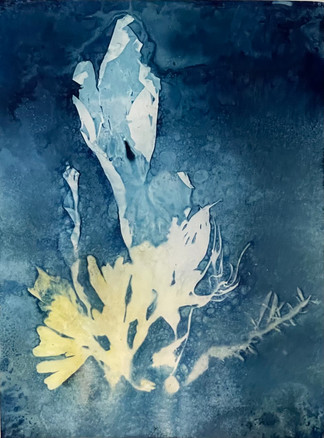I recently experimented with making seaweed cyanotypes.
Collecting specimens up on Whidbey Island was half the fun. After some time playing in the tidal quicksand, my kids helped.
Seaweed is quite challenging to work with. Out of the water, some varieties become slippery blobs that are difficult to lay flat on a surface without damaging them or the paper.
I'm certainly not the first person to do this. In fact, I was inspired by Anna Atkins who made the first photographic book, "Photographs of British Algae: Cyanotype Impressions," in 1843. The cyanotype process had only been invented a year earlier, by her neighbor Sir John Herschel, but she was the first to use it for making botanical photograms.
Anna Atkins didn't keep diaries or take notes so her process isn't well documented but around 17 of her original books still exist. In them, there are pin holes where she secured dry algae specimens in place atop her treated paper. She was also very careful to keep her paper dry, indicated by the smooth dark blue background in her work. I love imagining her rushing in and out of the sun in long dresses and petticoats.
Using Atkins as my inspiration but not wanting to even attempt to copy her iconic work, I used a different approach: the wet cyanotype method. Water, vinegar and soap bubbles created a sensation of movement, as if the seaweed was swaying in the waves.
The process was colorful (and only slightly stinky!) after carrying home some seaweed. The results were fascinating with the seaweed filtering the light in interesting ways and also depositing a good bit of their tannins to create detailed shapes on the paper. More abstract than my floral pieces but definitely interesting with an underwater feeling. You can see the all of my seaweed cyanotypes (now available as a set of Salish Sea Intertidal cards) HERE.
I encourage you to take a closer look at the work of the pioneering artist/biologist Anna Atkins. Her entire book can be viewed online at the New York Public Library Digital Collections. More information about her life and process can be found HERE.

















